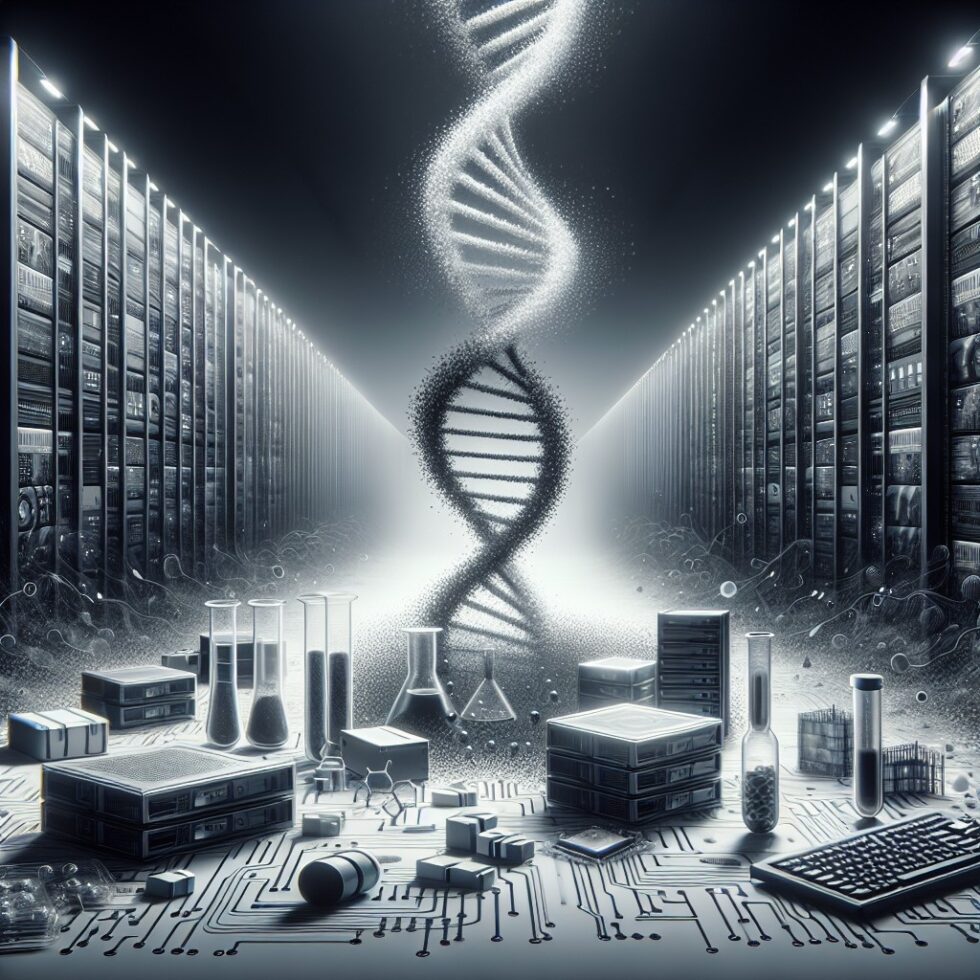
We make more data than our storage hardware can comfortably hold. Photos, sensor streams, compliance logs, and scientific datasets keep stacking up—even as drives grow. The cloud helps, but it is still racks of spinning disks and solid-state modules that sip energy every hour they sit online. A different path is taking shape in research labs and a few startups: keep data as sequences of DNA. It sounds like science fiction. It is not. DNA storage is a practical attempt to exploit a property biology discovered long ago: ultra-dense, durable information encoding in a stable molecule.
In this guide, we explain how DNA storage works from end to end, what the current limits look like, and why it is not a drop-in replacement for your SSD. We will also cover the early ecosystem of tools and services, and what to watch if you work with archives, compliance, or scientific data. The short version: DNA storage is slow to write, fast enough to read, astonishingly compact, and nearly idle on energy. That combination points at cold archives and long-term preservation, not your photo roll on a phone.
What DNA Storage Actually Is
At its core, DNA storage is a simple mapping problem. Digital data is a stream of bits—0s and 1s. DNA is a polymer built from four bases—A, C, G, and T. DNA storage schemes translate bits into base sequences, synthesize those sequences as physical DNA molecules, keep them safe, and later sequence the molecules to recover the digital data. The sophistication lies in doing this reliably, affordably, and at scale.
From bits to bases
A minimal scheme might map two bits to one base (00→A, 01→C, 10→G, 11→T). Real systems add constraints so the DNA is easy to handle: limit repeats of the same base, balance GC content to avoid folding, and add addresses so individual files can be pulled from a larger pool. Instead of long single strands, data is split into many short oligos (short DNA sequences), each carrying a slice of the file plus metadata and error-correcting codes.
Writing with chemistry
There are two main routes to “write” DNA:
- Phosphoramidite synthesis: a mature, widespread chemical process that builds DNA base by base on a solid support. It is highly accurate for short sequences but slow and relatively expensive per base at scale.
- Enzymatic synthesis: newer methods that use enzymes to add bases. They promise faster, cheaper, and greener writing but are still maturing in throughput and accuracy. Several companies and labs are racing to improve these systems.
Today, writing one megabyte of data as DNA can cost hundreds to thousands of dollars depending on provider, length, and redundancy settings. Prices are trending downward, and the pace of improvement—not the exact numbers—is the story to watch.
Reading with sequencing
To read, you sequence the DNA. Two dominant platforms make this practical:
- Short-read sequencing (e.g., Illumina): low error rates, high throughput, and mature workflows. It reads many short fragments in parallel, which aligns well with split-into-oligos storage strategies.
- Long-read sequencing (e.g., Oxford Nanopore): portable, field-ready devices that stream results in real time. Error rates have improved significantly, making nanopore attractive for fast retrieval. Real-time reads also enable adaptive sampling to focus on fragments that matter.
Most systems amplify the sequences they want with PCR and then sequence. The base calls are decoded into bits via the reverse mapping, and redundancy plus error-correcting codes reconstruct the original data.
Random access through addressing
DNA does not enforce a file system. You add one by embedding addresses—short, unique barcodes—at the ends of each data fragment. To retrieve a specific file, you use primers that match the barcode, amplify only those fragments, and sequence that targeted subset. This is how you can store thousands of files in one tube and still fetch the one you want.
Reliability, Errors, and How Codes Make It Work
DNA storage is not a clean channel. Errors emerge during writing, during PCR amplification, and during sequencing. Good systems plan for this noise from the start.
Three error types to expect
- Substitutions: one base read as another (A→G). These are common in some sequencers and are handled well by many codes.
- Insertions and deletions (indels): bases missing or extra bases misplaced. Indels are more disruptive than substitutions and push codec design toward robust strategies.
- Dropout: entire fragments fail to synthesize or are lost in handling. Physical redundancy—making multiple copies of each fragment—helps.
Error-correcting strategies
Practical pipelines layer several techniques:
- Constraints in encoding to avoid long homopolymers (e.g., AAAA…) and to keep GC content balanced, which reduces synthesis and sequencing headaches.
- Block codes (such as Reed–Solomon) to correct symbol-level errors within each fragment or across a set of fragments.
- Fountain codes that generate a flexible number of encoded packets, letting the decoder reconstruct the original data once enough distinct packets arrive, even if many are lost.
- Consensus building by reading many copies of each fragment and voting to establish the most likely sequence.
With careful design, bit error rates can be driven extremely low, even with noisy reads. The tuning knob is redundancy: more redundancy yields higher reliability and easier decoding, at the cost of longer sequences, more synthesis, and more reads.
Building a Practical Pipeline
If you were to design a DNA storage experiment or system, you would think in layers—very similar to building a network protocol or a file format.
1) Data preparation and chunking
Start by splitting your file into chunks small enough to fit within a targeted oligo length after adding addresses and codes. Common choices are 100–200 bases of payload per oligo, plus overhead. Add a file identifier and a fragment index to each chunk so the decoder can reassemble the file in order.
2) Codec and constraints
Choose an encoding that enforces base-level constraints. Many pipelines avoid runs of more than three identical bases and enforce a GC content window (say, 40–60%). Attach configurable error-correcting codes. The right mix depends on your sequencer, your synthesis quality, and how much you plan to amplify. A systematic code is handy because you can still retrieve some payload even if parity blocks fail.
3) Address design and random access plan
Decide how many unique barcodes you need and ensure they are well-separated in sequence space so they do not cross-react in PCR. Design primers that amplify only those addresses. Think of barcodes as file paths, and primers as the process that selects a directory from a pile of millions of tiny pages.
4) Write plan and manufacturing logistics
Choose a synthesis route. For small demonstrations, commercial providers can deliver pools of custom oligos on plates. For larger data volumes, specialized providers and emerging enzymatic systems promise higher throughput. Specify QC: desire length distribution, minimum yield, and purity. Decide on physical redundancy—how many copies of each fragment you want in the initial pool.
5) Storage conditions and longevity
DNA is happiest when dry, cool, and shielded from light and oxygen. Encapsulation in silica or other protective materials can extend stability to centuries. Compared with spinning disks that demand energy and periodic replacement, DNA in a shelf-stable cartridge has essentially zero standby power and a refresh cycle measured in decades. Label the container carefully with conventional barcodes and digital metadata; the toughest part of long-term archives is knowing what you have and how to decode it later.
6) Retrieval workflows
To read, pull a tiny portion of the pool, amplify with primers for the file you want, and sequence. Some workflows skip amplification for long-read devices, trading sensitivity for speed. Decoding software aligns reads, takes consensus, applies error correction, validates parity, and reconstructs the original bytes. The process can be scripted end-to-end to produce a standard file on disk.
Cost, Energy, and Where DNA Fits
DNA storage will not replace your cloud bucket this year. It might replace a small corner of your tape library sooner than you think. Understanding fit requires clear expectations on cost, energy, and latency.
What it costs today
Writing costs are the bottleneck. Even with pooling and short oligos, turning megabytes into DNA is expensive. Reading costs are much lower and dropping fast thanks to commoditized sequencing. Encoding and decoding software is negligible compared to wet-lab costs. The trend line is encouraging. Faster enzymatic writers and massive parallelization aim to drive the per-megabyte cost down by orders of magnitude. For planning, think of DNA today as a premium archival medium, like gold master tapes—used for select, high-value collections.
Energy and carbon
DNA excels at idle. Once synthesized and dried, a DNA archive consumes virtually no power. It does not idle, it just sits. Compare this to magnetic tape libraries that still require robotics, climate control, and periodic media refresh. Over a multi-decade horizon, the operational energy and emissions of DNA storage trend toward zero outside of read and write episodes. For institutions with net-zero goals, moving deep cold archives into DNA could be a meaningful slice of a carbon plan, provided synthesis becomes greener and cheaper.
Latency and access patterns
DNA is not a random-access SSD. Expect minutes to hours for targeted retrievals and days for large batches depending on inventory and sequencing queues. That makes it suitable for compliance archives, raw instrument dumps you rarely revisit, media preservation, and cultural heritage collections. Think of it as an offline vault you can query with a moderate delay, not a live content store.
Security, Safety, and Chain of Custody
DNA storage works with synthetic DNA outside living systems. There is no organism involved, and the sequences can be designed to avoid biological function. Even so, good practice matters.
Security practices
- Encryption before encoding: treat DNA as a physical layer. Apply strong encryption and authentication in software before mapping to bases.
- Chain of custody: manage vials and plates like any sensitive asset. Barcodes, logs, and tamper-evident seals help.
- Redaction and deletion: deletion is physical. You can discard vials, denature DNA, or chemically degrade it. Plan for destruction as deliberately as you plan for creation.
Safety and ethics
DNA strands holding data are not genes in a cell. Still, labs should follow biosafety rules: keep synthetic oligos out of biological workflows, label clearly, and prevent accidental introduction into cultures. Ethically, avoid encoding content that, if accidentally introduced into biological systems, could express anything meaningful. Most storage encodings already minimize this risk by enforcing constraints and staying in non-coding spaces.
A Young but Real Ecosystem
DNA storage sits at the junction of computation, chemistry, and logistics. A small, energetic ecosystem has emerged to make it practical.
Standards and shared challenges
Standardization will enable interoperability: file formats that record encoding parameters, metadata schemas for barcodes and primers, and methods for verifying integrity across decades. Public programs and challenges are pushing for repeatable benchmarks and cost reductions. They also fund work on automation—liquid handlers, microfluidics, and protocols that run overnight without human supervision.
Hardware and services
- Writers: commercial synthesis providers ship custom oligos today. Enzymatic writers under development promise speed and cost gains.
- Readers: short-read sequencers in core facilities and portable long-read devices make the read side accessible. Many universities can run jobs on short notice.
- Automation: programmable liquid handlers can assemble reactions and parallelize PCR, while small-form sequencers turn retrieval into a bench-top act.
Software and codecs
Open-source encoders and decoders are available in research circles. They implement GC balancing, homopolymer avoidance, and error-correcting codes. In practice, many teams customize their codecs after measuring their specific synthesis and sequencing error profiles—just as networking teams tune protocols for a given link.
Who Should Care Now
DNA storage will probably hit niche production first, then widen. If any of the following describes you, you may want to run a pilot:
- Archives and libraries preserving cultural assets for centuries, including organizations with digitized film, art, and government records.
- Scientific facilities generating petabyte-scale instrument data sets, where raw frames must be retained for regulatory or reproducibility reasons.
- Media companies with deep back catalogs kept primarily for remastering or historical access.
- Enterprises with large compliance archives that must be retained but are rarely accessed, where floor space and energy are at a premium.
A Small Walkthrough: From File to Tube
Imagine archiving a 50 MB report you must retain for decades. Here is a high-level process you might run at a partner facility:
- Prepare: compress and encrypt the report. Split it into 200-byte payload chunks.
- Encode: map chunks to bases with constraints. Add barcodes for the file and fragment indices. Attach error-correcting parity.
- Write: send sequences to a synthesis provider. Specify 10x physical redundancy per fragment.
- Store: receive a small vial of dried DNA in a sealed cartridge. Log location and decoding parameters in your digital asset system.
- Retrieve: five years later, pull a few nanograms, amplify with primers matching the file barcode, and sequence on a benchtop device. Decode, check authenticity, and recover the original encrypted file.
At every step, the processes can be automated. In mature settings, a robot handles plates and pipetting, a sequencer streams reads to a decoding server, and the file lands back in the archive with an audit log.
Open Questions and the Road Ahead
Several technical and economic questions will shape the next decade of DNA storage. The answers will determine whether it becomes a specialized tool or a mainstream archival pillar.
Can enzymatic writing scale without compromising accuracy?
High-throughput, low-cost writing is the key. New enzyme systems are making progress in speed and sustainability. The challenge is to keep error profiles predictable so encoders do not become too complex or wasteful.
How will we standardize file formats and metadata?
The data you keep for 100 years must be decodable by people who were not in the room. This implies durable, open metadata about encodings, barcodes, primer sets, and expected error-correcting codes. The archive should include a human-readable manifest and a digital twin of the decoding software environment for future reproducibility.
What is the best random access design?
Large collections need scalable addressing without primer cross-talk. Hierarchical barcodes and multiplexed PCR schemes look promising. Physical separation—storing categories in separate pools—can also reduce contention and speed retrieval.
How do we make the entire pipeline greener?
DNA’s steady-state energy profile is excellent, but synthesis and sequencing still consume reagents and power. Enzymatic processes, solvent recycling, and energy-aware lab automation can shrink the footprint further. Consider the whole lifecycle, including cartridge materials and transport.
Hands-On: How to Experiment Safely and Meaningfully
Curious teams can try DNA storage without building a full lab. A limited pilot teaches a lot:
- Start tiny: encode a few kilobytes, order a small oligo pool, and practice decoding with reads from a core facility or a partner lab.
- Benchmark: measure error rates from your provider and sequencer choice. Tune your codec accordingly.
- Automate: script the encode/decode steps. Treat them like build artifacts with version control and tests.
- Document: capture all parameters—primer sequences, GC constraints, redundancy levels—in a manifest stored alongside the vial.
- Collaborate: partner with a university core lab or a service provider that can handle PCR and sequencing with proper biosafety.
Do not try to grow anything. These are inert fragments, and they should stay that way. Your pilot aims to validate cost, feasibility, and integration with your digital asset management—not biological engineering.
Why This Matters Beyond Storage
DNA storage can be a wedge for broader molecular information technology. Once you can reliably encode, move, and read DNA for data, other ideas follow: molecular tagging for supply chains, watermarks for physical objects, and hybrid systems where chips talk to molecules for long-term memory. None of this replaces conventional computing. It adds an option where silicon struggles: ultra-long lifetimes, density, and low-power preservation.
Watchlist: Signals That DNA Storage Is Getting Ready
- Rapid cost drops reported by enzymatic writing vendors with third-party benchmarks.
- Turnkey cartridges you can order with clear capacity, shelf life, and barcoded manifests.
- Open standards for encoding manifests and primer libraries, endorsed by multiple labs.
- Integration with existing archive software so a “DNA tier” is a storage target like tape.
- Case studies from libraries, studios, and scientific facilities recovering data years later.
Bottom Line
DNA storage is not a universal cure for our data glut, but it is a sensible, physics-aligned answer for deep cold archives. It uses a medium nature already proved in terms of density and stability. With better writers and clear standards, it can become an everyday option for organizations that care about keeping data intact for lifetimes, not just product cycles. If you manage archives or plan for long-term digital stewardship, it is wise to learn the basics now, run a small pilot, and track the ecosystem’s rapid progress.
Summary:
- DNA storage converts bits into base sequences, synthesizes them as oligos, and reads them via sequencing.
- It shines in density, durability, and near-zero standby energy, making it ideal for cold archives.
- Error handling uses constrained encodings, block and fountain codes, and consensus from multiple reads.
- Random access is achieved with barcodes and targeted amplification of specific files.
- Costs are currently driven by writing; enzymatic synthesis is the main lever for price drops.
- Security relies on encrypt-then-encode, strict chain of custody, and clear destruction methods.
- Early adopters include archives, research institutions, media libraries, and compliance-heavy enterprises.
- Standards for manifests, barcodes, and codecs are crucial for century-scale preservation.
- Practical pilots are feasible today using synthesis providers, sequencing services, and open-source codecs.





